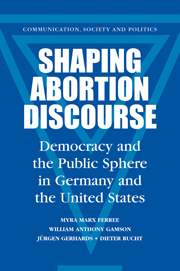Book contents
- Frontmatter
- Contents
- Tables and Figures
- Foreword by Friedhelm Neidhardt
- Preface
- Glossary
- Part I Introduction
- 1 Two Related Stories
- 2 Historical Context
- 3 Methods
- Part II Major Outcomes
- Part III Representing Different Constituencies
- Part IV The Quality of Abortion Discourse
- Methodological Appendix
- References
- Index
2 - Historical Context
Published online by Cambridge University Press: 15 December 2009
- Frontmatter
- Contents
- Tables and Figures
- Foreword by Friedhelm Neidhardt
- Preface
- Glossary
- Part I Introduction
- 1 Two Related Stories
- 2 Historical Context
- 3 Methods
- Part II Major Outcomes
- Part III Representing Different Constituencies
- Part IV The Quality of Abortion Discourse
- Methodological Appendix
- References
- Index
Summary
If Germany and the United States have reached somewhat similar compromises on abortion policy, they have arrived there by quite different historical paths. In this chapter we trace the paths by which law and policy were shaped in each country over the past century. Perhaps the most fundamental difference is that Germany went through intense debates on abortion in the first third of the twentieth century while the United States witnessed what Luker (1984) aptly labeled a “century of silence.”
Abortion emerged (or, in the case of Germany, reemerged) as a controversial public issue in the last third of the twentieth century. We will review the “critical discourse moments” that have occurred in both countries during the contemporary period. Critical discourse moments are events that stimulate news articles and commentary in various public forums – in this case, especially legislative actions and court decisions. These events sometimes change the discursive opportunity structure and, therefore, necessarily require the would-be players to interpret the event in terms of their preferred frame and, in some cases, to reevaluate their discursive strategy.
PROLOGUE
UNITED STATES
In the first two-thirds of the nineteenth century, abortion was largely unregulated in the United States, especially before “quickening.” It was not a matter to be discussed openly in public although abortion providers advertised their services in coded form (see Olasky 1988). A movement in the last third of the century changed this situation, making abortion illegal except under special circumstances.
This movement was part of a broader effort by physicians to secure their medical authority against the competition of other healers by delegitimizing them as “quacks” and “charlatans.”
Information
- Type
- Chapter
- Information
- Shaping Abortion DiscourseDemocracy and the Public Sphere in Germany and the United States, pp. 24 - 44Publisher: Cambridge University PressPrint publication year: 2002
